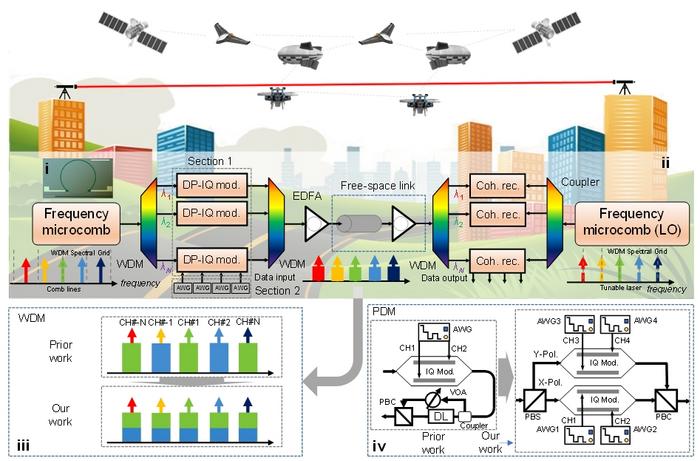In a monumental advancement for the field of optical communication, researchers at the University of California, Los Angeles (UCLA) have unveiled innovative technology that employs Platicon frequency microcombs to facilitate terabit-speed data transmission through free space. The landmark study, published in the journal eLight, marks the first instance of utilizing chip-level microcombs for coherent optical communication over distances of up to 160 meters. This revolutionary achievement achieves astonishing speeds of 8.21 terabits per second, showcasing remarkable stability even amid fluctuating atmospheric conditions. The developments may pave the way for addressing ever-increasing bandwidth demands, particularly as the world edges closer to the rollout of sixth-generation (6G) communication networks.
Optical frequency combs, born from groundbreaking research recognized with the Nobel Prize in Physics in 2005, have become instrumental across numerous scientific and engineering disciplines. These intricate systems consist of multiple frequency components that are precisely spaced and phase-stable, making them essential tools in high-precision time-frequency science, advanced spectrometry, and, notably, high-speed optical communication networks. In light of the striking acceleration of semiconductor micro-nano fabrication technology, integrated frequency combs have begun to emerge as vital components in myriad advanced applications—from optical computing to futuristic radar systems and quantum optics.
Facing an insatiable need for communication bandwidth contributed greatly by the emergence of 5G technologies and the anticipation of 6G, free-space optical communication (FSO) has garnered significant attention as an alternative to conventional radio-frequency communications. This method is distinguished by its substantial bandwidth potential, heightened security garb, and reduced infrastructure costs, positioning it as a promising solution for overcoming the "last mile" challenges that would inevitably arise with conventional fiber-optic deployment. Nevertheless, existing FSO approaches often utilize arrays of multi-laser systems, grappling with scalability and efficiency issues, while frequently compromising quality due to environmental turbulence and alignment issues.
UCLA’s research team introduced a formidable solution through their effective implementation of integrated microcavity optical frequency comb systems that can produce hundreds of phase-locked optical carriers sourced from a single pump laser. Historically, the application of traditional microcombs in free-space scenarios was curtailed by challenges in conversion efficiency and power uniformity. However, the introduction of the Platicon microcomb in this study resolved these impediments, thanks to its distinctive spectral shaping and innovative energy conversion methodologies.
At the heart of this breakthrough is the design of the Platicon frequency microcomb, which is based on a silicon nitride (Si₃N₄) micro-ring resonator architecture. The microcomb operates through the generation of a flat spectral output that presents a rectangular profile across a 12.5 THz C/L-band, resulting in over 55 optical carriers that are spaced by 115 GHz. Impressively, the optical carrier-to-noise ratio (OCNR) achieved a robust 50 dB, laying the foundation for sophisticated high-density wavelength division multiplexing (WDM) and polarization multiplexing (PDM) efforts, which are paramount for enhancing channel capacity.
When subjected to rigorous testing conditions, the research team employed advanced 16-state quadrature amplitude modulation (16-QAM) strategies, with a symbol rate reaching as high as 20 Gbaud per carrier. These configurations enabled the dual-polarization IQ modulator to successfully maintain stable data transmission across a 160-meter atmospheric pathway. Notably, even when impacted by turbulence-induced log-normal intensity scintillation and misalignment, the system consistently maintained a bit error rate (BER) below the forward error correction (FEC) threshold of 4.5 x 10⁻³, whilst achieving an impressive spectral efficiency of 1.29 bit/s/Hz.
Confirming their leadership in innovation, the research team also tackled the challenge of atmospheric turbulence head-on by engineering an active beam stabilization system that reduced positional fluctuations by a factor of ten. A pioneering carrier phase recovery technology based on the microcomb was employed, allowing real-time monitoring of carrier phase fluctuations and compensation for associated disturbances caused by turbulence. Such advancements emphasize the significant reduction in complexity and power requirements, attributing only an additional 0.5 dB power penalty at identical BERs when compared to traditional commercial laser systems.
The implications of this technology are far-reaching and strategically poised to redefine multiple facets of communication as we know it. The emergence of Platicon microcombs could spell the end of disparate multi-laser modules, offering dedicated low-cost, high-capacity terabit backhaul routes for modern millimeter-wave and radio-over-fiber hybrids essential for the anticipated 6G ecosystem. Furthermore, the technology stands to revolutionize satellite and ground connectivity, seamlessly facilitating inter-satellite laser communications and bolstering low Earth orbit satellite engagements with terrestrial infrastructure.
In crisis scenarios, this technology could also function as a backbone for high-speed communication in disaster relief situations, bridging communication gaps in regions without established fiber optic networks, thereby empowering real-time operational collaborations, even in swarm deployments of drone technology. As Professor Wang Wenting aptly noted, these achievements set the groundwork for a comprehensive framework in space information transmission that is becoming increasingly crucial for modern communication infrastructures.
As researchers continue to innovate, the prospects of microcomb technology hint at a potentially transformative future for communication architecture globally, promising a shift toward a more integrated and efficient "space information superhighway." Future endeavors will focus on further enhancing the power efficiency and conversion capabilities of these microcombs, both to facilitate extended data transmission over longer distances and to integrate with artificial intelligence-powered algorithms for optimized spectral utilization.
The realization of coherent optical communication via Platicon microcombs heralds not only an impressive technical milestone but also represents the dawn of a new era of chip-integrated optical communication systems that are expected to lead the way for next-generation networks. As the standardization of 6G accelerates, these breakthroughs will likely redefine the landscape of global communication infrastructures, unlocking new capabilities that will shape the future of connectivity.
Subject of Research: Free-space terabit coherent optical communication using Platicon microcombs
Article Title: Free-space terabit/s coherent optical links via platicon frequency microcombs
News Publication Date: October 2023
Web References: 10.1186/s43593-025-00082-0
References: eLight Journal
Image Credits: Wenting Wang, Hao Liu et al.
Keywords
Optical frequency combs, Terabit transmission, Free-space optical communication, 6G networks, Platicon microcombs, Atmospheric turbulence, Integrated photonics, Communication networks, Signal processing, Optical data transmission, Innovation in communication technology.




